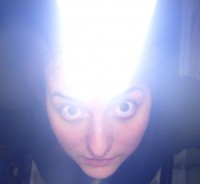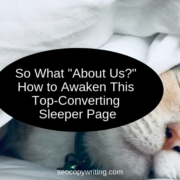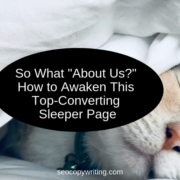How to Write Sales Copy That Turns Your Readers On
 Greetings! Ready to get your brain influence on?
Greetings! Ready to get your brain influence on?
Inspired by neuromarketing expert Roger Dooley’s SEO Copywriting Certification presentation, Heather gets into how to write sales copy that turns your readers on…meaning, your readers’ brains.
If you write sales copy or landing page content, or if you work with copywriters, then you’ll definitely want to tune in and learn how to write sales copy that turns on your prospects’ brains and sparks conversions…
I’m talking about BRAINS…
For last week’s SEO Copywriting Certification training call, we were honored to have guest speaker Roger Dooley, author of Brainfluence: 100 Ways to Persuade and Convince Consumers with Neuromarketing.
If you haven’t yet read this book, I highly recommend that you do – especially if you’re a copywriter, or work with copywriters, and/or you simply want to make your web copy better!
One of the things Roger talked about during his presentation is how you can use adjectives, and specifically how to…
“Use vivid, sensory, emotional adjectives to engage the brain.”
-Roger Dooley
This is something that of a lot of copywriters forget – we get in a habit of writing copy in a certain way, and we forget the power of adjectives.
Words related to texture activate the brain
Now the cool thing about using those sensory adjectives is that they can actually activate your readers’ brains.
The brain can actually picture – as evidenced by brain scans – what silky would feel like, or smooth or rough: the brain actually “lights up” as if imagining those particular textures.
So when you use these sensory-laden words in your writing, you are actually engaging more of your reader: you’re really turning them on. And now you’re thinking not only about what your copy reads like, but also what it sounds like!
– Silky
– Smooth
– Rough
– Bright
– Jagged
– Slimy
Source: Roger Dooley, NeuroscienceMarketing – “Persuade with Silky Smooth Copy – Substitute sensory metaphors to engage your reader’s brain”
[http://www.neurosciencemarketing.com/blog/articles/metaphor-marketing.htm]
The list above indicates some adjectives that are possible sensory substitutes, like “jagged” and “slimy” and “bright.” For more information on this, check out Roger’s article – I highly recommend it!
So let’s see how this might work when you’re writing content…
For example…
In his article (referenced above) Roger uses the example of:
“Having a bad day vs. Having a rough day”
While they mean the same thing, that texture of “rough” does something a little bit different: it engages the brain a little bit more. More examples are:
“She touched the rock vs. She touched the jagged rock”
“Made the fresh eggs vs. Made the freshly-cracked eggs”
“Your skin will feel soft vs. Your skin will feel silky to the touch”
and, my favorite example: “My cat is soft vs. My cat is fuzzy”
If this is something you don’t do automatically when writing copy, let it sit for awhile and then go back and see how you can add these textural adjectives to your content.
Energizing your copy with textural adjectives can actually improve conversion rates – something that Roger Dooley’s article also discusses. So definitely try it out and see how it works for your own web copy!
photo thanks to Sarah G…







Thanks for this, Heather – great post. I was just thinking, you can combine them for an even bigger sensory picture too: “smooth as chocolate,” “rough as a blanket”.
Getting carried away!
Love it! Your suggestions are as smooth and silky as a newborn kitten’s fur… :)